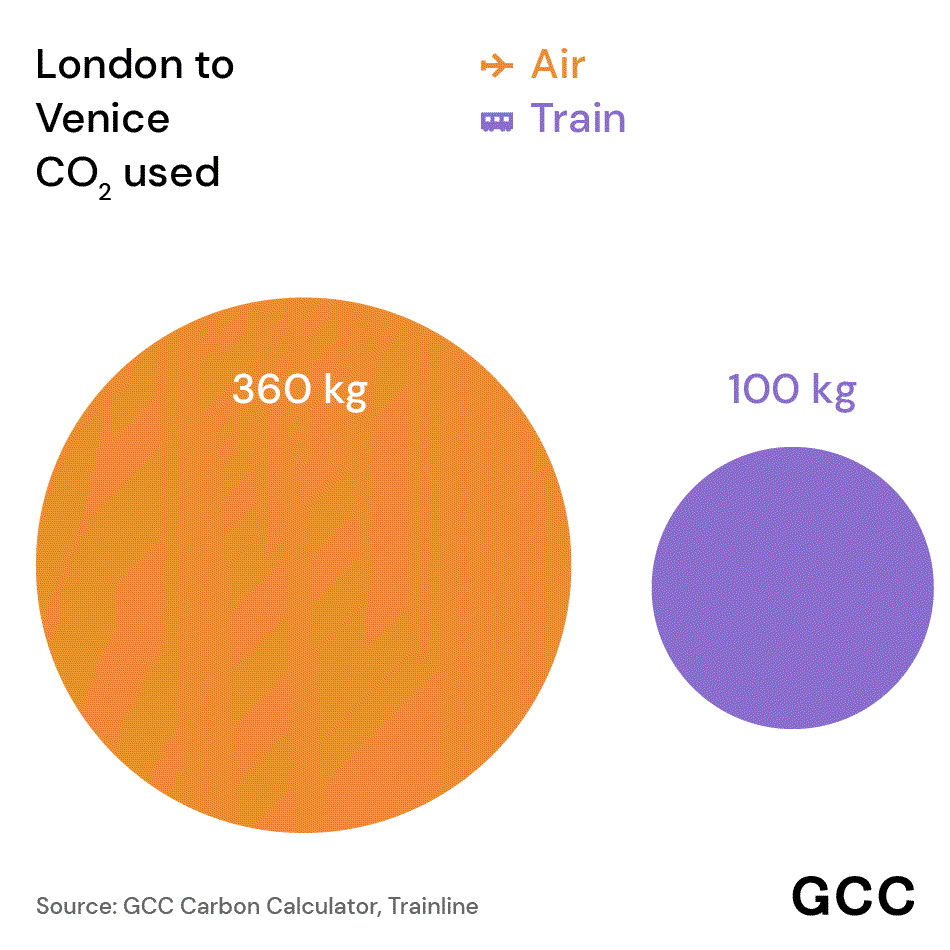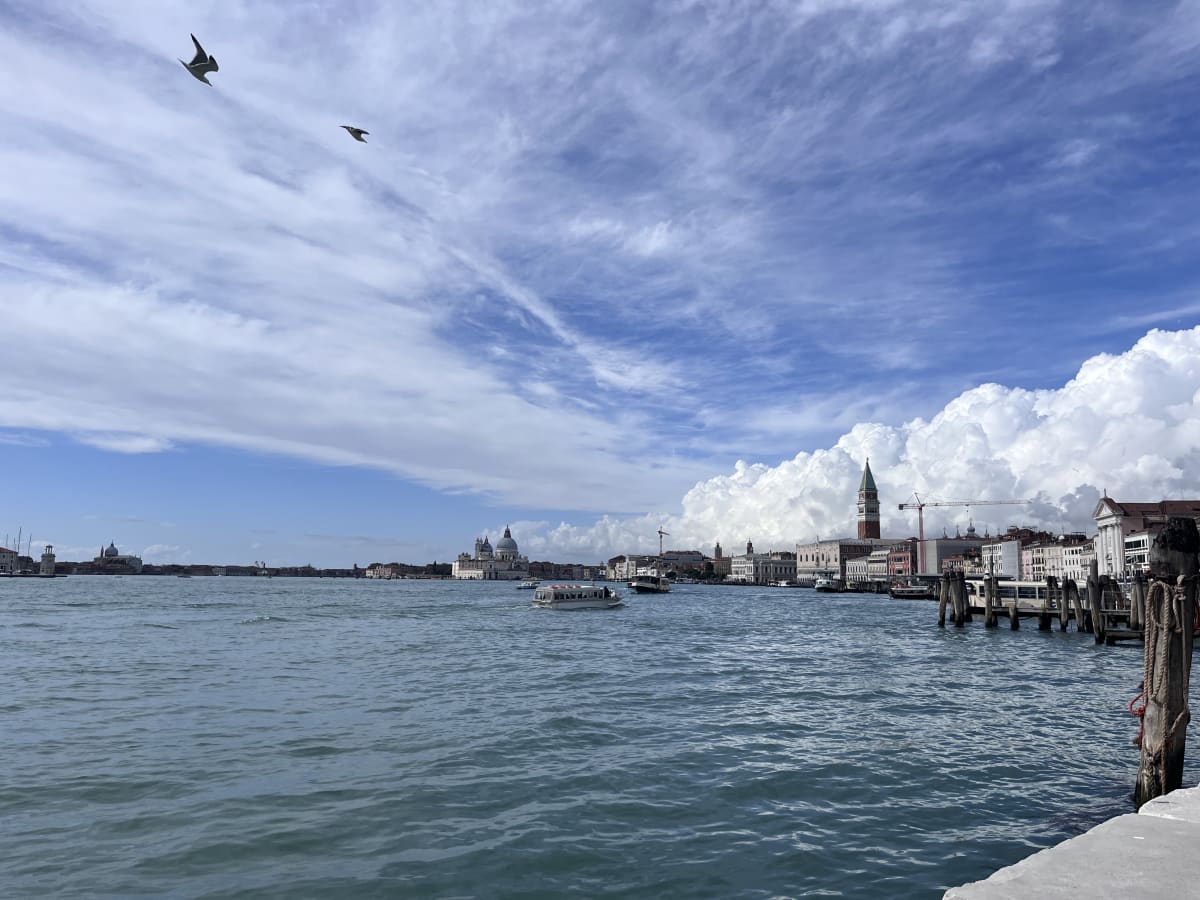How to take the train to... the Venice Biennale
The 60th Venice Biennale opens later this month, and as part of our ongoing Climate Conscious Travel campaign, GCC is encouraging everyone who is able to take the #TraintoVenice.
Choosing train travel over a flight will significantly reduce your carbon emissions, and if as many people as possible choose to travel overland we could make a substantial difference.
Read on to find out how choosing the train can dramatically reduce the environmental impact of your visit, and how you can plan your train journey to Venice.
Climate Conscious Travel
At GCC we advocate for climate conscious travel. This means seriously considering the impact of our journeys, and, importantly, addressing the amount that we fly.
This is because stepping on a plane is the single most carbon-polluting action we can take as an individual in our everyday lives. The data we’ve collected through GCC’s carbon calculator shows that air travel is typically one of the biggest contributors to most galleries’ carbon footprints.
We acknowledge that the art sector is an international community built on connection, and it’s not always realistic for us to stop travelling entirely. But by taking advantage of the public transport connections that already exist, particularly within Europe, we can reduce or remove our reliance on flights, stay on track to meet 2030 emissions reductions targets, and continue to meet and connect with each other.
In other words, taking the train instead of flying is one major way that we can all reduce our impact, now.
Venice Biennale 2024
For those visiting Venice this month, there are many realistic alternatives to flying, particularly for those travelling within Europe.
If you’re able, GCC encourages everyone to take the #TrainToVenice. Rail travel is the fastest and most practical alternative to getting on a plane.
While the journey time may be longer, inter-city train journeys that take you from centre to centre can save time spent travelling to and from airports and time spent in transit. For some routes, the overall difference is negligible.
It’s also worth considering how we think about our journeys. With more comfortable seating, extra space, WiFi connectivity, and power sockets, train journeys can be treated as a more scenic day in the office.
Meanwhile, stopovers and connections can be a chance to take in other cities and connect with colleagues—if you’re travelling to Venice from London, for example, you could plan some meetings or an exhibition visit in Paris, Zürich or Madrid en route.
GCC’s Content Coordinator Bethany recently took the train from London to Venice, stopping overnight in Paris en route and taking in the Swiss Alpine scenery along the way.
We know that travel costs are important, but train travel between well-connected cities, especially if you book far in advance, can be similar in price to short-haul flights.
Most importantly, the carbon savings we make by taking the train are huge. We’ve compared emissions generated by single journeys by train and plane between Venice and London and Paris – and you can see what a difference it makes:


Tips for travel
Whether you’re travelling from within mainland Europe or beyond, there are plenty of resources available to help you plan and book your journey.
The Man in Seat 61 has published a wealth of in-depth guides to train travel all over the world, including hundreds of routes within Europe. Trips can be planned and booked in advance using websites like Rail Europe or Trainline.
For visitors to Venice travelling with Italy, nearby Milan offers around 38 trains per day to the city. It’s a direct connection, so there are no changes, and journey time is an average of 2 hours. The average cost of a ticket is around €22.
There are also direct routes to Venice from Italian cities including Rome, Florence, Naples, Turin, and Bologna, as well as nearby Zürich and Münich.
A direct train line usually runs between Paris and Milan, but this was blocked by a landslide in August 2023 and is currently set to remain closed until the end of the year. However, visitors can still travel relatively simply between the French capital and Milan, where you can take a connecting train on to Venice.
A scenic option is the train from Paris-Gare de Lyon to Geneva, Basel or Zürich, which takes between 3-4 hours, followed by the train to Milan, with a journey time of around 4 hours, and a connecting train to Venice, which takes around 2 hours. This means travel is still possible in a day, while more leisurely travel allows for a stop in a city of your choice - with the added benefits of a scenic view and plenty of time to relax or work on board the train.
A second option for visitors from Paris is a temporary once-daily TGV train that runs directly between Paris and Milan, with a portion of the journey, between Saint-Jean de Maurienne and Oulx, made by bus to avoid the landslide. This has the benefit of a direct connection and a journey time of nine hours.
From London, catching the Eurostar to Paris and then travelling on to Venice via Madrid can take as little as 13 hours. For a more leisurely journey, visitors can spend a day or evening in Paris or Zürich, Basel or Geneva en route.
In short, taking the train may require a little more forward planning, but the journey can be practical, affordable, and even more enriching and fulfilling, covering impressive Alpine landscapes and taking in key cities en route.
Changing the culture
It might seem that one less flight to Venice won’t make much of a difference, but together, the collective impact could be transformative.
The arts sector isn’t alone in needing to address its travel habits: many industries rely on frequent, high-impact international travel. It’s time for all of us to consider how we can change long-held norms and create a new climate conscious culture, and taking the train is one way you can play your part.
Sharing tips and ideas is another way to help everyone in the community make meaningful changes. So, if you’re making plans to travel to Venice, GCC encourages everyone who is able to take the #TrainToVenice and share your travel plans. Tag us in your posts and stories, or reach out ahead of time to share your journey so that we can feature your trip as a member case study!
-
This blog is part of our wider Climate Conscious Travel campaign, which encourages everyone to take action to reduce the carbon impact of their journeys. For more inspiration, see our previous blogs on travel to Art Basel, Frieze London, ARCOmadrid, STAGE Bregenz and TEFAF Maastricht, or visit GCC’s best practice guidelines on Travel.

